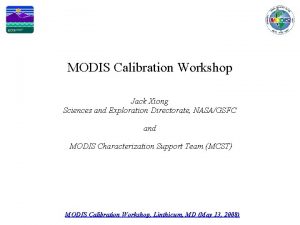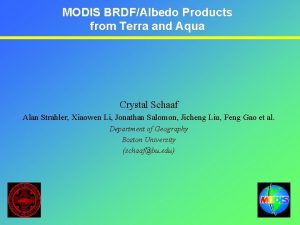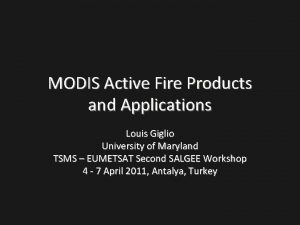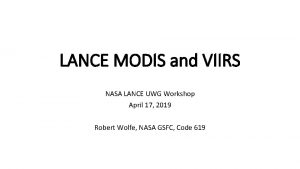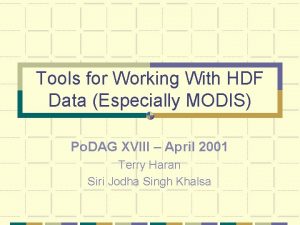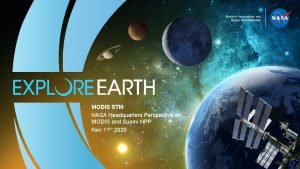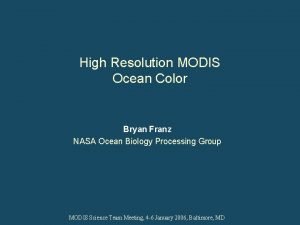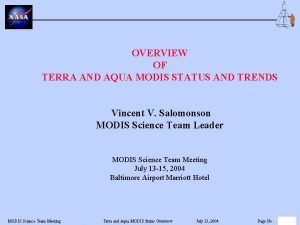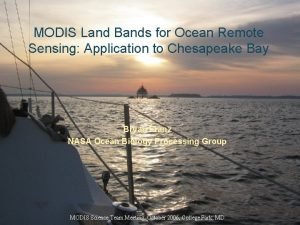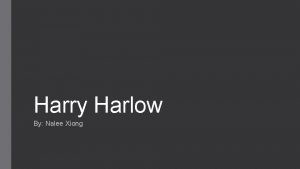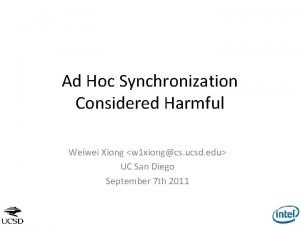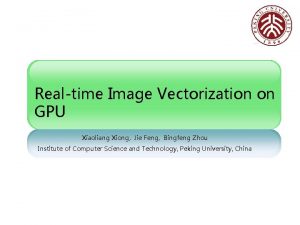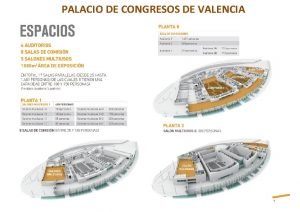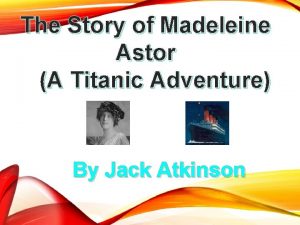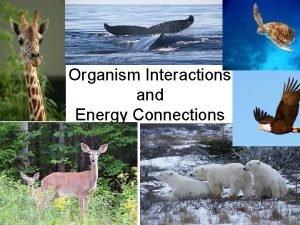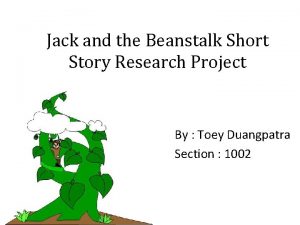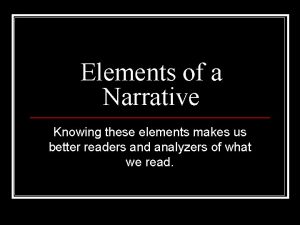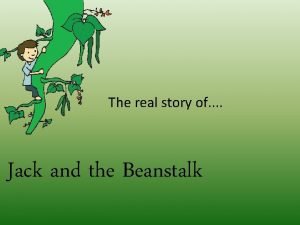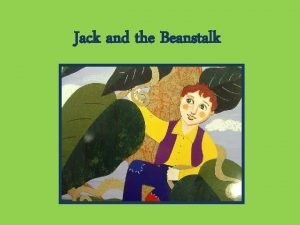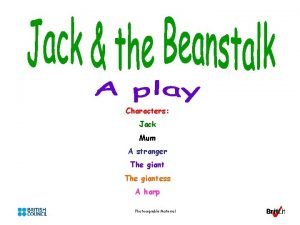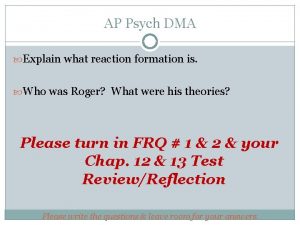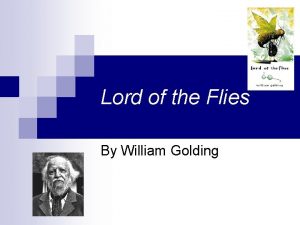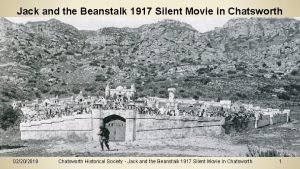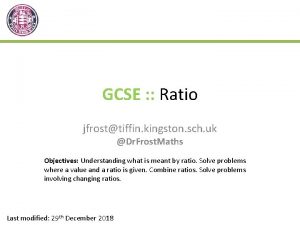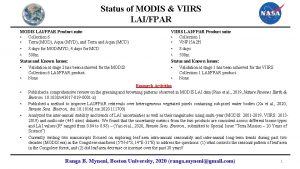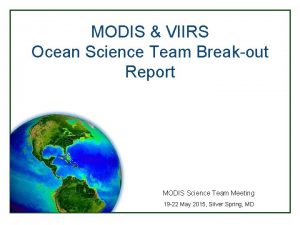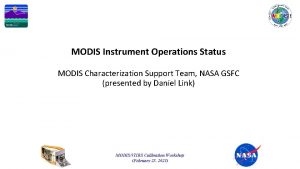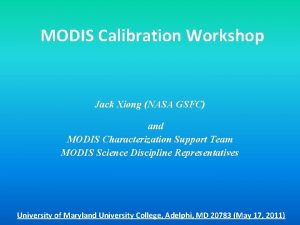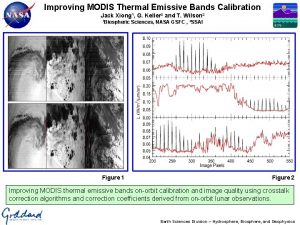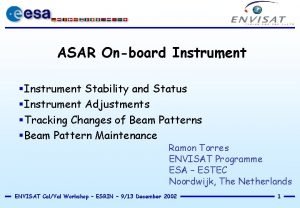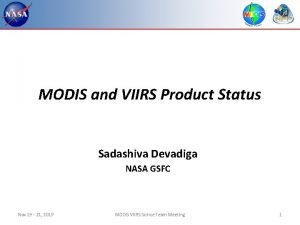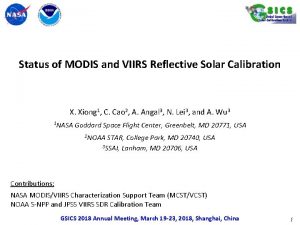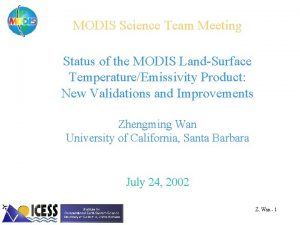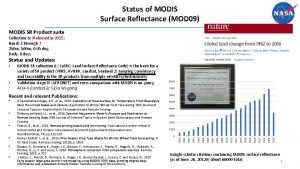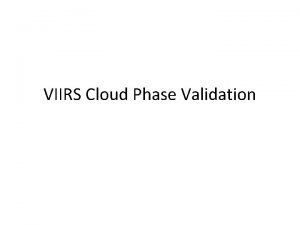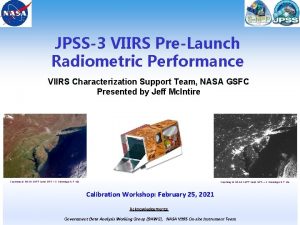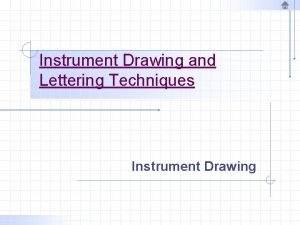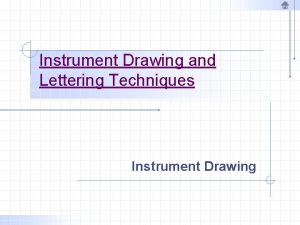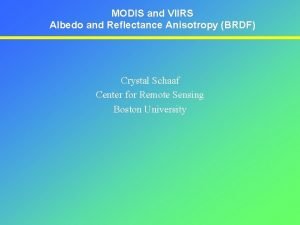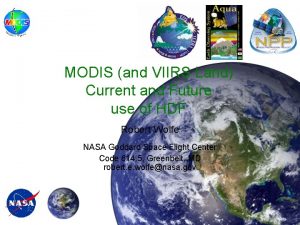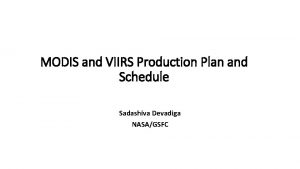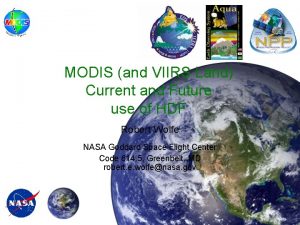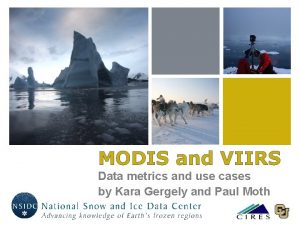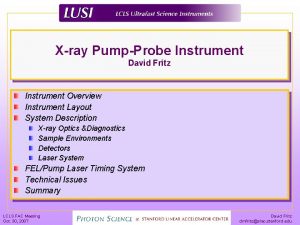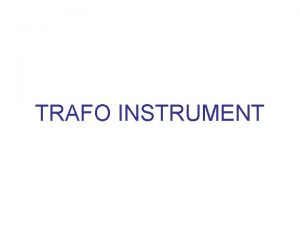MODIS and VIIRS Instrument Status Jack Xiong and



































- Slides: 35

MODIS and VIIRS Instrument Status Jack Xiong and Jim Butler Code 618. 0, NASA Goddard Space Flight Center, Greenbelt, MD 20771 MODIS and VIIRS Science Team Meeting, Silver Spring, MD (June 06 -10, 2016) 1

Acknowledgements Contributions: − MODIS Characterization Support Team (MCST) − MODIS Science Data Support Team (SDST) − VIIRS Characterization Support Team (VCST) Support: − Terra and Aqua Projects, S-NPP Project Science Office (PSO), and JPSS Flight Project − MODIS/VIIRS Discipline Groups and Representatives − Terra, Aqua, S-NPP Mission/Flight Operation Teams (MOT/FOT) − MODIS and VIIRS Instrument Vendor (Raytheon) 2

Outline • • • MODIS and VIIRS Highlights MODIS and VIIRS On-orbit Performance MODIS C 5/C 6 and VIIRS SDR/L 1 B Status (backup slides) Future Activities Summary 3

MODIS Highlights • Instrument Operations and OBC Functions – Normal – No changes to instrument operation configuration for Terra MODIS since 2003 (currently using A-side electronics and B-side formatter) – All B-side configuration for Aqua MODIS since launch – Terra spacecraft (S/C) safe mode on Feb 18, 2016 § It happened on Feb 18, 2016 during a scheduled inclination maneuver when the S/C was yawed to +90° instead of the desired -90°. When attempts were made to slew it back, the edit limits were tripped and caused the S/C to enter the Safe Mode § The S/C and all instruments were powered back on without issues after February 24, 2016 and continue to operate nominally § Impact on MODIS: 11 (21) noisy detectors in LWIR bands before (after) safe mode; large gain changes (5 -15%) in some LWIR PV bands/detectors; gain changes are relatively small (0. 5 -2. 0%) in other spectral bands – No new noisy detectors for Aqua MODIS since last STM – Noticeable improvement in the control of Aqua MODIS CPFA temperatures 4

MODIS Highlights • Continuous Effort on Sensor Calibration and LUT Delivery – Terra MODIS: C 5/C 6/OBPG LUT updates: 16/16/13 (19/19/18 in previous year) – Aqua MODIS: C 5/C 6/OBPG LUT updates: 14/16/14 (17/16/14 in previous year) Calibration Activities Terra Aqua Lunar Roll: 162 (13*) 136 (13) PV Ecal: 92 (4) 71 (4) SRCA: 433 (21) 315 (26) BB: 99 (4) 61 (4) SD/SDSM: 715 (17) 571 (35) * (activities) since last STM 5

MODIS Highlights • C 5/C 6 Processing and Reprocessing – Backup slides (from SDST) • MODIS Publications 1666 since last STM Citation: 19. 1/article – 10906 tech articles and 14813 tech article and proc. combined (Web of Science) • Technical Meetings and Workshops – MODIS and VIIRS Calibration Workshop on June 06, 2016 – Aqua MODIS CFPA Performance and Operation Review on May 04, 2016 (previous reviews in 2010, 2012, 2013, 2014, and 2015) – Bi-weekly Ms. WG meetings – Technical meetings with science groups § Most with OBPG on LUT updates; other topics include Aqua MODIS (B 14) RVS update strategy and Terra MODIS LWIR PV xtalk assessment 2175 since last STM Citation: 14. 8/article 6

S-NPP VIIRS Highlights • Instrument Operations and OBC Functions – Normal – Same operation configurations (B-side) since launch – “Scan Sync Loss” between RTA and HAM: 64 since launch (2 -3 min); poor geolocation accuracy – “Petulant Mode” - the single board computer (SBC) lock-up not occurred since a FSW fix in Dec 2014 (FSW: 0 x 4016) – Optical throughout degradation has nearly leveled off • On-orbit Calibration and SDR/L 1 B LUT Delivery – – SD calibration: each orbit; SDSM: 3 times/week BB WUCD: 17 since launch DNB: monthly VROP operation lunar observations: 41 since launch (not all need roll maneuvers) – 35 sets of LUTs for RSB (and DNB) delivered for Land SIPS SDR processing of C 1. 0 and C 1. 1 (Oct 2012 – present); 9 sets of LUTs delivered to Atmosphere SIPS (Nov 2014 – present) 7

S-NPP VIIRS Highlights • VIIRS Publications – Total number of 264 (citation 8. 4/article) • Technical Meetings and Workshops – Regular Technical Meetings of VCST and OBPG – VIIRS L 1 B Working Group Meetings – VIIRS SDR Meetings (led by NOAA STAR) • Continues effort on L 1 B algorithm and LUT improvements – POC: Fred Patt and Vincent Chiang – Latest effort on L 1 V 2 SW (details in Calibration Workshop materials) • J 1 and J 2 VIIRS Instrument Status – J 1 VIIRS currently undergoing SC environment testing (sensor per-launch calibration performance summarized during last year’s STM and also at this year’s calibration workshop) – launch in early 2017 – J 2 VIIRS recently started its ambient environment testing 8

MODIS and VIIRS Calibration Workshop § 24 presenters from MCST/VCST and sci. discipline representatives on a variety of topics (xtalk, polarization, calibration difference) § 75± 5 attendees MCST and VCST Presentations: ftp: //mcst. ssaihq. com/pub/temp/ Available at MODIS Website after the STM 9

Terra and Aqua MODIS On-orbit Performance • Instrument and On-board Calibrators (OBC) – Terra MODIS instrument, VIS/NIR FPA temperature increase: < 3. 5 K; CFPA temperatures: very stable; BB temperature increase: < 30 m. K: SD degradation: faster than Aqua MODIS (SD door fixed at open since 2003) – Aqua MODIS instrument, VIS/NIR FPA temperature increase: < 2. 0 K; CFPA temperatures: improved control; BB temperatures: very stable; SD degradation: slower than Terra MODIS • Radiometric – Spectral band responses – Detector noise characterization • Spatial and Spectral (no change since last STM) – Band-to-band registration (BBR): continue to be stable – Center wavelengths and bandwidths: changes are within 0. 5 nm and 1. 0 nm, respectively, for most VIS/NIR bands; relatively large changes for bands with broad bandwidths (bands 1, 18, 19) • Geolocation 10

MODIS BB Temperature and SD Degradation Excellent Stability 30 m. K increase over 16 years 11

MODIS Detector Noise Characterization MODIS: 36 spectral bands (on 4 FPAs); a total of 490 individual detectors • Terra MODIS: 53 noisy detectors (30 from pre-launch; 35 at launch) and 3 inoperable detectors (D 6 in B 29 D 4 and D 8 in B 30) – 8 noisy detectors and 3 inoperable detectors since last STM • Aqua MODIS: 10 noisy detectors (2 from pre-launch; 3 at launch) and 15 inoperable detectors (13 in Band 6) – no change since last STM Terra MODIS: 21 of the 26 noisy and inoperable detectors since launch are in LWIR PV bands 11 of the 21 occurred after the safe hold event in Feb 2016 12

MODIS Geolocation Performance Terra and Aqua MODIS Geolocation Performance Remains Satisfactory (same as last year) Terra MODIS RMSE (C 6) Track: 43 m Scan: 44 m Aqua MODIS RMSE (C 6) Track: 46 m Scan: 53 m Terra track direction jump - due to a delayed implementation/update of Geo LUTs (from 01/01/2013 to 08/10/2013). Aqua track direction jump at the end of 2011 (now it’s back to “normal”) - need to model it and update the LUT. 13

S-NPP VIIRS On-orbit Performance • Instrument and On-board Calibrators (OBC) – Instrument and FPA temperatures: stable – SD degradation: relatively large (similar to Terra MODIS) – BB stability: very stable (similar to Aqua MODIS) • Radiometric – Spectral band responses (different from MODIS) • Large changes in NIR and SWIR (due to mirror contamination) • Small changes in VIS, MWIR, and LWIR – Detector noise characterization (better performance than specification) • Noticeable changes in NIR and SWIR are due optical throughput degradation • Spatial and Spectral – Band-to-band registration (BBR): stable (tracked using lunar observations) – Mirror contamination => wavelength dependent optics degradation • Geolocation 14

S-NPP VIIRS BB Temperature and SD Degradation BB Temperatures § ~15 m. K offsets due to the use of two different TBB settings § Long-term stability to within a few m. K SD Degradation A-MODIS VIIRS T-MODIS § Large SD degradation at short wavelength § Increased SD degradation in Terra MODIS after its SD door fixed at “Open” § VIIRS has no SD door 15

S-NPP VIIRS Spectral Band Responses (Gains) Lunar: symbols; Solar: curves § Large changes in NIR and SWIR (due to mirror contamination) § Small changes in VIS, MWIR, and LWIR 16

S-NPP VIIRS Detector Noise Characterization SNR/SNRSPEC > 1 or NEd. T/NEd. TSPEC < 1: better performance SNR for RSB NEd. T for TEB 17

S-NPP VIIRS Spatial Characterization and Geolocation S-NPP VIIRS RMSE (C 1. 1) Track: 72 m Scan: 61 m § Methodology was developed for MODIS BBR characterization using lunar observations (validated using MODIS on-board SRCA) § On-orbit BBR is very stable in both scan and track directions Terra MODIS RMSE (C 6) Track: 43 m Scan: 44 m Aqua MODIS RMSE (C 6) Track: 46 m Scan: 53 m 18

Future Activities • Future work to address existing and new challenging issues in Terra and Aqua MODIS – Changes in VIS/NIR response versus scan-angle (RVS) – continuing effort – Changes in Terra MODIS polarization sensitivity and impact on sensor’s earth view response trending – progress has been made in recent years – Uncertainty due to correction for large SD degradation and SD degradation correction for SWIR bands – further improvement (for more spectral bands) – Terra LWIR PV Xtalk impact and correction – testing latest correction algorithm – Noisy detectors and their impact on calibration – more serious in Terra MODIS LWIR PV bands • VIIRS calibration effort – Enhanced calibration and validation effort in support of VIIRS data reprocessing and NASA L 1 SW development/improvement – Improved use of SD and lunar calibration – Tracking potential changes in VIIRS RVS • MODIS and VIIRS calibration consistency and impact on science products – Extensive calibration and validate effort and science support 19

Future Activities • J 1 and J 2 VIIRS calibration work – Support to current J 1 VIIRS testing in SC environment – Support to ongoing J 2 VIIRS sensor ambient environment testing – Support to J 1 launch (early 2017) and J 1 VIIRS intensive calibration and validation (ICV) • Senior Review 2017 – Kick off in December, 2016 – Proposal due in March, 2017 – 7 th for Terra; 6 th for Aqua; and 1 st for S-NPP (? ) 20

Example: Electronic Crosstalk in the LWIR PV Bands of Terra MODIS • Calibration Issues Associated with Electronic Crosstalk • Band-to-band signal contamination during sampling among the LWIR PV bands • False drift in the trending radiometric calibration coefficients • Detector-to-detector differences result in image striping and overall poor quality images • False land features observed in Bands 27 -28 • False cloud detection in the Band 29 – Band 31 cloud mask due to radiometric offset • Our Approach • Developed lunar-based and electronics based physical models and an empirical model to correct the contamination • Derived correction coefficients for using lunar based approach for the full mission • L 1 B granule testing of our coefficients show better quality images. Good removal of false features and suppression of radiometric calibration coefficient drift. • Current Issues • Continue to monitor the impact of the safe-mode event on the crosstalk contamination • Assess the impact of our correction on downstream science products • Finalize our implementation and begin forward processing of the L 1 B granules 21

Example Corrections from the Lunar Based Algorithm Correcting the Lunar Signal De-striping and Land Feature Removal in Band 27 Signal limited to < 200 Band 27, Detector 1 08/04/2015 Corrected Uncorrected Granule 2015183. 1005 Removal of False Clouds from B 29 – B 31 Cloud Mask Gain Coefficient Drift Correction b 1 averaged over all detectors Granule 2015182. 1345 BT Terra MODIS safemode event, 02/18/2016 22

Summary • Both Terra MODIS (16 years) and Aqua MODIS (14 years) and their onboard calibrators continue to operate and function normally • Dedicated effort by MCST (and SDST) and support from science algorithm developers remain critical to MODIS instrument calibration/data product quality • Challenging issues identified for both MODIS instrument calibration will be investigated and addressed for future improvements of data processing/reprocessing • SNPP VIIRS on-orbit performance (4. 5 years) has become very stable • Effort from VCST is vital in support of SIPS for producing the improved and consistent VIIRS data products • Multiple and major instrument calibration activities in the coming year will be more challenging for both MCST and VCST 23

Backup Slides 24

MODIS C 5 Forward Processing Status • Forward processing (C 5 Land, and C 51 Atmosphere) is typically 1 -2 days behind real time. • The C 4. 1 LST (C 4 code with C 5 L 1 input) is processed and archived at LAADS. • C 5/C 5. 1/C 4. 1 processing to be continued for a year after completion of the C 6 land atmosphere reprocessing. • Products from the C 5 processing are expected to be available from DAAC for a year after completion of the C 6 land reprocessing. C 5 processing could be discontinued in late 2016 or Spring 2017. • NRT processing (C 5 Land, C 51 Atmosphere and C 6 Land Atmosphere) is completed typically 2 – 2. 5 hours after acquisition of data. 25

MODIS C 6 Reprocessing Status • L 1, Geolocation, and L 1 B – C 6 reprocessing of Terra and Aqua completed in 2012. – Forward processing of Terra and Aqua L 1 B started in 2012 and is currently at leading edge. – Terra L 1 B “reprocessed” in August 2014 to address trending in Band 5. – C 6 L 1 Products have been available to public since late 2012 from LAADS. 26

MODIS C 6 Reprocessing Status • Atmosphere Products – – Reprocessing of L 2 products from Aqua MODIS started in Dec 2013 and completed in April 2014. Reprocessing of L 2 products from Terra MODIS started in Oct 2014 and completed in March 2015. Reprocessing of L 3 product from Aqua MODIS completed in April 2015, and Terra MODIS in Sept 2015. C 6 Products have been available to public from LAADS: L 2 Aqua MODIS since Jan 2014 and Terra MODIS since Dec 2014; L 3 Aqua MODIS since May 2015 and Terra MODIS since Oct 2015. Details in Reports at the Atmosphere break out session 27

MODIS C 6 Reprocessing Status • Land Products – Reprocessing of Tier 1 block of products, including Land Surface Reflectance, Vegetation Index, LAI/FPAR, GPP, Sea-Ice, and Active Fire started in Feb 2015 and completed in Jan 2016. Forward processing of these products started in Jan 2016. These data have been released to public. – Reprocessing of Teir 1 block products BRDF-Albedo and Land Surface Temperature products and Tier 2 Snow product expected to complete in August 2016. C 6 Algorithm changes for Teir 2 block products, including MAIAC, LST from JPL, Burned Area, Land Cover and Land Cover Dynamics, VCF, Evapotranspiration, Daily Radiation and PAR, are currently under development and science testing. Reprocessing of these products will start following approval of the C 6 algorithms by the product PIs. – Details in Reports at the Land Break out session 28

S-NPP VIIRS Land SIPS • Forward processing – – – Generates the VIIRS Land L 1 B SDRs, L 2 swath products (IPs and EDRs) using mix of IDPS OPS PGEs and Land SIPS variation of IDPS PGEs, and the L 3 gridded products using the Land SIPS DDR algorithms. L 1 B SDRs are generated from processing of NASA L 1 A using IDPS SDR calibration algorithms. Products are generated in HDF 4/HDF 4 -EOS format and are available to public from AS 3002 of LAADS. Most L 2 and L 3 daily products have retention period of 30 days. Some L 3 daily and n-day products may be available for longer mission period. Products were generated using the incremental build versions from IDPS, with build version Mx 8. 11 in use since March 4, 2016. Land SIPS will not install any future IDPS algorithm revisions. Processing of data prior to April 1, 2016 used IDPS RDRs aggregated to ~5 min granules. Since then Land SIPS processing has been using the 5 min granules of NASA L 1 A generated from the NASA L 0 data. Details in Reports at the Land Break out session 29

S-NPP VIIRS Land SIPS • C 1. 1 reprocessing – – Generated VIIRS land data products from beginning of the NPP mission (Feb 19, 2012) through Jan 31, 2016. Included L 1 B SDRs, L 1/L 2 swath products (IPs and EDRs) generated using the Mx 7. 2 based IDPS OPS algorithms and Land SIPS variation of the IDPS algorithms, and L 3 daily and n-day tiled products generated using the DDR algorithms based on the C 5/C 6 MODIS L 2 G/L 3 algorithms. L 1 B SDRs are generated using the calibration LUTs provided by the NASA VCST. Products are in HDF 4/HDF 4 -EOS format and is available to public from AS 3110 of LAADS. Details in Reports at the Land Break out session 30

S-NPP VIIRS Land SIPS • V 1 Processing – – – – Will generate the MODIS heritage VIIRS products proposed by the NASA VIIRS science team. L 1 B is generated by processing the NASA L 1 A using the NASA calibration algorithm and L 1 B LUTs provided by the NASA VCST. L 2 and L 3 products are generated using the NASA science team delivered algorithms. Science team delivered algorithms are used in the V 1 forward processing and reprocessing when they are approved by the science teams. Algorithms for Land Surface Reflectance, Fire and Snow product are currently in science testing. Processing of Land Surface Reflectance Product suite is expected start in June 2016. L 1/L 2 products are in HDF 5/netcdf 4 and L 3/L 4 products are in HDF 5 -EOS format. Products are available to public from LP-DAAC and from LAADS. NRT processing of VIIRS LSR and Fire products with Session-based L 0 data is completed typically about 3. 5 hrs after acquisition of data. Details in Reports at the Land Break out session 31

MODIS Spectral Band Responses (Gains) 32

MODIS Instrument Operation No Changes to both Instrument Operation Configurations and OBC fucntions since Last Science Team Meeting (details on MCST website) Terra MODIS Aqua MODIS • • Launch: May 04, 2002 • First light: June 24, 2002 • B-side: launch - present Launch: Dec 18, 1999 First light: Feb 24, 2000 A-side: launch - Oct 30, 2000 B-side: Oct 30, 2000 - June 15, 2001 A-side: July 02, 2001 - Sept 17, 2002 A-side electronics & B-side formatter: since Sept 17, 2002 • BB nominally set at 290 K • SD door fixed at “open” since July 02, 2003 • SRCA operated with 2 10 -W lamps since 2006 • CFPA controlled at 83 K (briefly at 85 K: 3 -5 Aug 2000) • BB nominally operated at 285 K • SD calibration: gradually reduced frequency • SRCA operated with 2 10 -W lamps since 2005 • CFPA controlled at 83 K (small increase of CFPA temperatures since 2007) 33

Technical Articles: 5119 Avg. Citation: 14. 4/article Tech & Proc. Articles: 7365 Avg. Citation: 10. 6/article Goggle Scholar (05/12/2015) MODIS Publication Metrics NASA Hubble: 114, 000 Technical Articles: 6176 Avg. Citation: 15. 2/article Technical Articles: 7406 Avg. Citation: 14. 7/article Tech & Proc. Articles: 8865 Avg. Citation: 11. 2/article Tech & Proc. Articles: 10, 054 Avg. Citation: 10. 8/article NASA MODIS: 76, 500 NASA Landsat: 54, 800 Goggle Scholar (05/31/2016) NASA Hubble: 149, 000 NASA MODIS: 101, 000 Technical Articles: 9240 Avg. Citation: 17. 72/article Tech & Proc. Articles: 12, 738 NASA Landsat: 68, 100 34

16 Moderate (radiometric) bands, 5 Imaging bands, 1 DNB VIIRS and MODIS Spectral Bands 1 DNB 14 RSB (0. 4 -2. 3 mm) Dual Gain Bands: M 1 -M 5, M 7, M 13 7 TEB 35
 Jack xiong
Jack xiong Jack and the beanstalk character traits
Jack and the beanstalk character traits Modis competence center
Modis competence center Modis
Modis Lance modis
Lance modis Modis
Modis Modis hq
Modis hq Modis
Modis Aqua terra modis
Aqua terra modis Modis bands
Modis bands Maijue xiong
Maijue xiong Alonzo harlow israel
Alonzo harlow israel Vong xiong
Vong xiong Li xiong
Li xiong Weiwei xiong
Weiwei xiong Xiong jie
Xiong jie Ning yun wu xiong
Ning yun wu xiong Hmong shaman rituals
Hmong shaman rituals Passive instrument is
Passive instrument is Jack and madeleine astor
Jack and madeleine astor Desert biome producers
Desert biome producers Jack and beanstalk short story
Jack and beanstalk short story Exposition of jack and the beanstalk
Exposition of jack and the beanstalk The real story of jack and the beanstalk
The real story of jack and the beanstalk Jack and his mother were hungry
Jack and his mother were hungry Jack london and naturalism
Jack london and naturalism Jack and the beanstalk once upon a time
Jack and the beanstalk once upon a time Jack and the giantess
Jack and the giantess Jack and jill french revolution
Jack and jill french revolution Hello my name is jack and this is sue
Hello my name is jack and this is sue Three blind mice psychosexual stage
Three blind mice psychosexual stage We might get taken prisoner by the reds
We might get taken prisoner by the reds 1917 movie map
1917 movie map Jack kate and lila share some money
Jack kate and lila share some money Adam sandler monica
Adam sandler monica Business plans derby
Business plans derby
